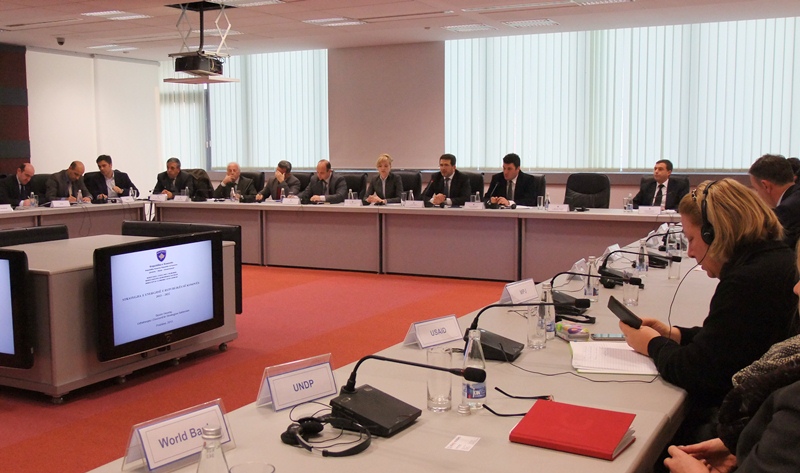Ismajli: Energy Strategy 2013-2022 – Efficiency a top priority
Prishtina, 18.12.2013 – Considerable efforts have been put in the drafting of the Energy Strategy 2013-2022, and there certainly have been dilemmas in some areas which had to be clarified so that the strategy is able to cover all options for the next ten-year period in the electricity sector in Kosovo, said the Minister of Economic Development, Fadil Ismajli.
The Minister made these comments today in the public debate on the Energy Strategy of the Republic of Kosovo 2013-2022, in the presence of heads of MTI, MESTP, KEK, KOSTT, ERO, donors, civil society, and other stakeholders.
Minister Ismajli said that extensive consultations have been conducted with stakeholders, donors, international financial institutions and not with a part of the civil society, after which we are organizing this public hearing.
“We have also received many comments and the majority of them have been incorporated in the final draft, in particular those of international financial institutions, and some of the civil society. This is the main segment that will accelerate economic development of other sectors, as every investment, external or internal, above all requires security of power supply, which is also one of the main investment criteria”, he added.
Ismajli said that whether we want it or not, have to review, based on economic principles, what are the most appropriate sources for power supply, and also meet the environment criteria, which is an obligation the Government of Kosovo has assumed from the third energy package, those that are implementable, and we also have to adhere to the Industrial Emissions Directive and the Acquis Communautaire on the environment and energy.
“The draft you all have in front of you was developed in different approach. You have noticed that there aren’t many figures and there aren’t many dates, because we thought we should stick to the definition of the Strategy, and make a distinction from planning. Because of this there are no figures, which will be defined in another section, in terms of capacity, potential sources for electricity generation from RES or conventional sources, which in our case means coal. But if you read the document carefully you may notice that for the next ten-year period, particular attention will be put in energy efficiency”, said the Minister.
According to him, investments in energy efficiency will not have an impact in energy tariff increase, such as RES, but rather has the opposite effect. Ismajli added that feed-in tariffs are already being implemented and ERO has taken a decision to include wind tariffs, set at 8.5 euro per kW/h, and now is working in the other tariff methodologies for RES, such as solar, biomass, etc., which is expected to be completed in 2014, creating an environment conducive of RES investments. On the other hand, EE projects have already started to be implemented through the Western Balkans Initiative, World Bank, KfW, and recently a $16 m. loan has been approved from WB, with the aim of enhancing energy efficiency in public buildings.
“The plan for the next year is to do a comprehensive study on the possibilities of facilitating all energy efficiency projects, including fiscal incentives for materials and products that have an EE certificate, and to work in the Construction Law, which will specify materials and products that are in compliance with the requirements for energy efficiency certificate”, said the Minister, and added that there have been discussions with banks and financial institutions to support commercial banks for soft loans during the implementation of projects that use EE materials and products, and which result with energy savings.
According to the Minister, this study will include and define a more specific financial impact on the Kosovo Budget, on one hand, if we would consider fiscal incentives, and benefits of the energy sector which justify such incentives. On the other hand, the basis to ensure security of electricity supply in the country is still coal, regardless of RES and EE project development.
Ismajli also stated that EE will have an impact in reducing the capacities of coal generators, but that we cannot avoid the utilization of conventional sources, less so given the fact that in Kosovo coal constitutes a comparative advantage, and is the cheapest electricity source, as it ranks 5th globally with reserves, and amongst the first in terms of exploitation conditions.
“However, it is very important that the generators planned to be constructed in Kosovo have the highest possible efficiency, and are fully in line with EU directive on Industrial Emissions, and apply best available techniques”, he added.
According to the Minister, in addition to this, the Strategy envisages a further optimization of energy utilization, which directly or indirectly impacts the environment, and that is the opening of the regional market.
“Despite some delays, we are very close to reach an agreement with Albania for the construction of a common market, which means a parallel work of both systems, a higher optimization. The terms of reference have been developed for this project, and there is a donor interest”, said Ismajli.
He illustrated this with the valorization of electricity generated from coal in Kosovo in off-peak hours and real valorization of peak hours when hydropower capacities in Albanian kick in.
Finally, Minister Ismajli talked about the RES component, and said that several small and medium hydropower plant projects are underway, and will lead the fulfillment of obligations in Renewable Energy, and Energy Efficiency, and with them Kosovo is close to fulfilling the obligations we have assumed from the international community/EU to fulfill the 20/20/20 standard.

